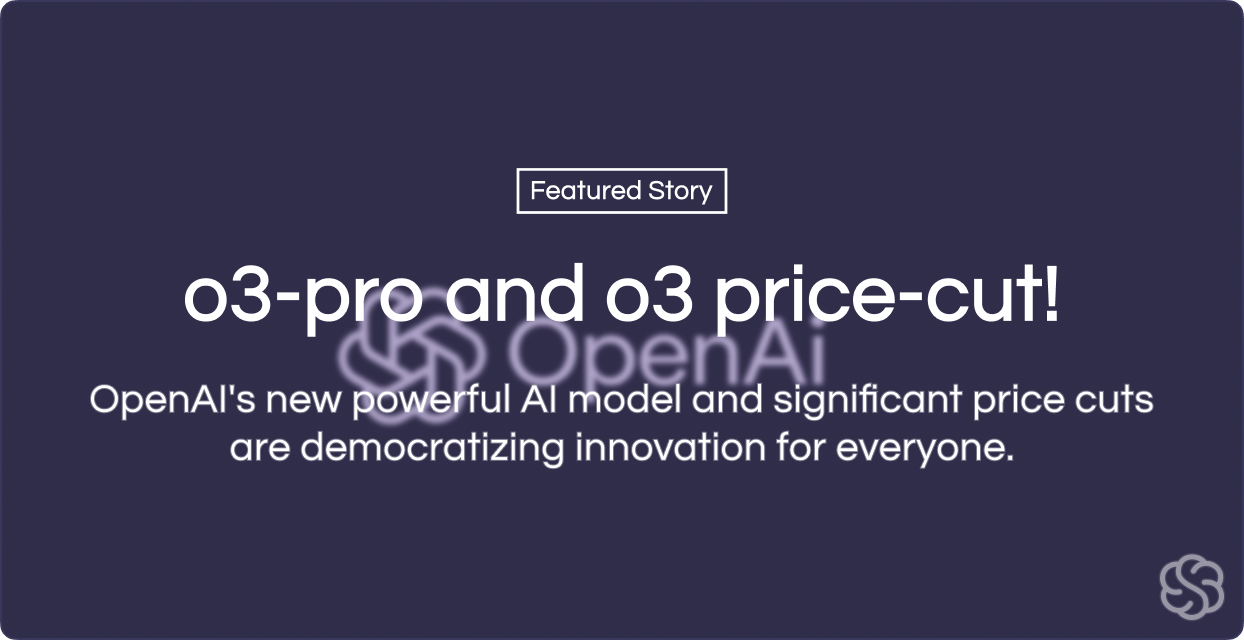Dear Readers,
Something has changed. Not quietly, not gradually - but with a bang. OpenAI has not only released o3-pro, the most advanced publicly available reasoning model, but has also reduced the price of o3 by a whopping 80%. This combination is like a one-two punch: technical excellence meets radical democratization.
The message is clear: intelligence is becoming cheap - and therefore limitless. Projects that were computing budget killers yesterday are becoming feasible today. Ideas that lay dormant in notion docs can suddenly be translated into prototypes - from AI-supported therapists to autonomous coding agents.
In the midst of the hype, however, it is worth taking a quiet moment: what happens when “reasoning” becomes not only scalable, but also affordable? What cultural, economic and creative spaces will then open up? o3-pro is more than an upgrade - it is a symbolic step towards mass-available superintelligence.
In Today’s Issue:
OpenAI's new model and 80% price cut is a massive game-changer for AI
Meet Magistral, the new AI model that thinks like a specialized expert and shows its work
Sam Altman reveals why you should stop worrying about copycat startups
Intelligence "too cheap to meter" is accelerating innovation for everyone
And more AI goodness…
All the best,

o3-pro and o3 price-cut!
The TLDR
OpenAI has launched o3-pro, its most powerful reasoning model yet, while also making the standard o3 model 80% cheaper. This combination of increased power and drastically lower costs is set to accelerate innovation by making advanced AI more accessible to developers and startups.
With the release of o3-pro, OpenAI is setting a new standard for reasoning models. It is currently the most powerful publicly available model that not only understands text, but can also think through complex tasks logically, program and analyze images. Particularly noteworthy: at the same time, Sam Altman announced an 80% price reduction for the basic o3 model - a move that made the AI world sit up and take notice.
While o3-pro will be activated for Pro users and API customers, the price drop marks a paradigm shift: what was premium yesterday is becoming mainstream today. Developers, start-ups and creative tinkerers can now experiment with computing power that was previously reserved for large corporations.
Massive cost reductions combined with increased performance means: more innovation, faster prototypes, more open playgrounds for bold ideas.
Increasingly, the statement: intelligence too cheap to meter is becoming a reality. Even the best models are becoming significantly cheaper.
Why it matters: OpenAI not only makes advanced AI more powerful, it also makes it accessible to everyone. This democratizes innovation and accelerates technological progress for the entire community.
Sources:
Ad
Looking for unbiased, fact-based news? Join 1440 today.
Join over 4 million Americans who start their day with 1440 – your daily digest for unbiased, fact-centric news. From politics to sports, we cover it all by analyzing over 100 sources. Our concise, 5-minute read lands in your inbox each morning at no cost. Experience news without the noise; let 1440 help you make up your own mind. Sign up now and invite your friends and family to be part of the informed.
In The News
Introducing Magistral
We are officially announcing Magistral, our first reasoning model designed to master complex, specialized subjects. It excels by providing transparent, step-by-step logic and operating seamlessly across multiple languages.
Ignore the Copycats
According to Sam Altman, founders should not worry about copycat startups, as studies show they almost always fail. He explains that imitators lack a true sense of mission and are always a step behind, so the best strategy is to ignore them.
Graph of the Day
The gap between ChatGPT and X visits has recently widened significantly. However, both websites continue to grow, albeit at a much faster rate for OpenAI.

The Illusion of Thinking
Researchers have investigated the actual thinking abilities of the latest AI models. What's new about this is that instead of using standard benchmarks, they used logic puzzles with systematically increasing complexity to analyze the thinking process itself. The key finding is sobering: even the best models fail completely at a certain point. Their “thinking” often appears to be an illusion based on pattern recognition rather than genuine logic. Fundamentally new approaches are therefore required for truly generalizable problem solving.
Robot-R1
Researchers have taught robots a new way of thinking. Instead of just feeding them examples, their “ROBOT-R1” system uses a kind of reward-based training: the AI has to correctly predict the robot's next step and is rewarded for the right “train of thought.” This method is so effective that a small special model even outperforms the AI giant GPT-4o in precise control tasks. This could lead to significantly more capable and efficient robots for industry and everyday life.
Thinker: Learning to Think Fast and Slow
Researchers have taught AI “fast and slow thinking.” Inspired by human psychology, their new “Thinker” method breaks tasks down into four steps: intuitive quick response, verification, slow thinking, and summary. The result: AI becomes significantly more accurate at complex math problems. This could lead to more efficient and human-like problem solvers that learn when quick intuition is enough and when in-depth analysis is necessary – an important step toward more powerful AI.
Question of the Day
Quote of the Day

Sponsored By Vireel.com
Vireel is the easiest way to get thousands or even millions of eyeballs on your product. Generate 100's of ads from proven formulas in minutes. It’s like having an army of influencers in your pocket, starting at just $3 per viral video.













